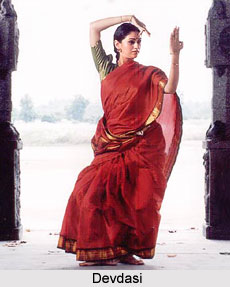 Devadasi is a Sanskrit term meaning female servant of God. They are the female dancers and singers attached to the temples. In Hindu religious practice young girls were "married" to a deity. This system of offering of votive girls to the deities in Brahmanic temples is a system found in all parts of India but most prevalent in the south. They are not allowed to marry any mortal man and are called `Nitya Sumangalis`.
Devadasi is a Sanskrit term meaning female servant of God. They are the female dancers and singers attached to the temples. In Hindu religious practice young girls were "married" to a deity. This system of offering of votive girls to the deities in Brahmanic temples is a system found in all parts of India but most prevalent in the south. They are not allowed to marry any mortal man and are called `Nitya Sumangalis`.
Process of Dedication of Devdasis
The process of the dedication of the devdasis follows certain rules. During the initiation ceremony the priest ties a bead necklace around the girl`s neck singing the praises of Goddess Yellamma. Yellamma is believed to be an incarnation of Goddess Kali. After the completion of the ritual as a mark of respect all the villagers offer her kumkum and betel leaves and wash her feet. As per the custom the new devdasi has to visit five houses to beg for food grain. This marks the end of the ceremony. Next day, the food grain collected by her is used in the Preparation of `Prasadam` to Yellamma. Every morning, after bathing the girl has to visit the temple to watch the worship of Yellamma. She is however, not allowed to enter the sanctum sanctorum of the temple. She only she bows to the goddess from outside. Later as she grows up she is trained by the senior devadasis. Singing and playing musical instruments in honour of the temple goddess is the main function of a devadasi.
Sometimes, the dedication process takes place even before the birth of the girl or when she is just a few years old. As a vowed gift to the deity, the girl solely becomes attached to the temple. In Telangana areas there are few other ways of initiation. The young girl chosen to be the devdasi usually between the ages of five and nine is married to potharaju, the brother of Yellamma. She is dressed in yellow garments and smeared with turmeric powder from head to foot. The yellow colour is regarded as very auspicious during this religious ceremony. She is also adorned with flowers and treated as a bride. The priest performs her marriage to potharaju by tying a `mangalsutra` around her neck on behalf of the goddess. After the ceremony she is called the `Nityasumangali.` The girl is regarded as a privileged person. In Karnataka, the girl`s initiation ceremony is called `Jogipattam`. The nuptial ceremony with the landlord or any person who undertakes to give her financial support is called `Mailapattam`.
Thus the practice of dedicating young girls to deities has been prevalent throughout South India and name been assigned some name or other. Invariably, these dedications were purportedly done for the common good of villages, to as to avert a calamity or a means to overcome it.




















